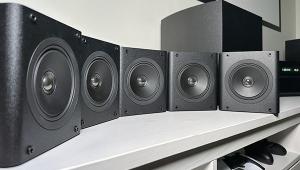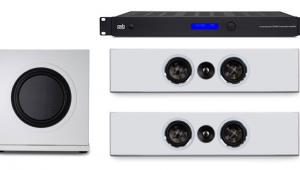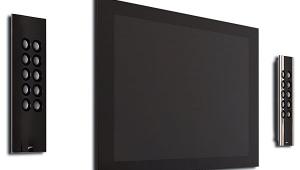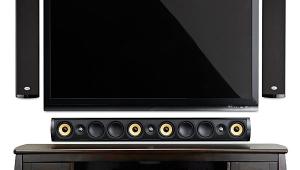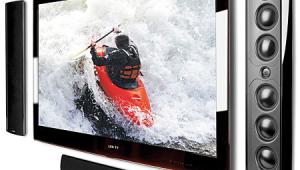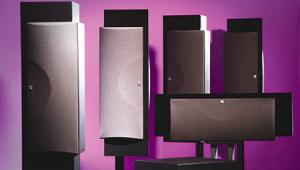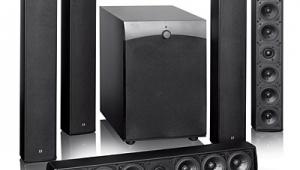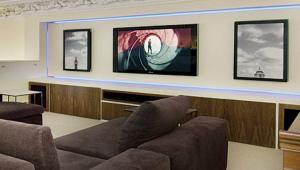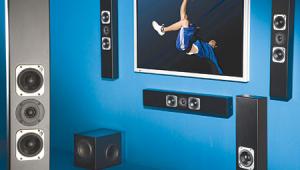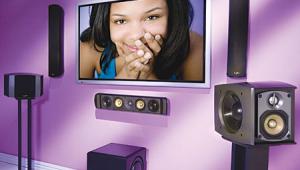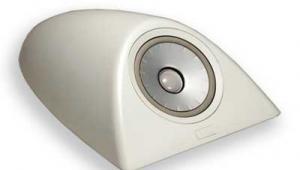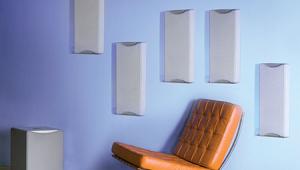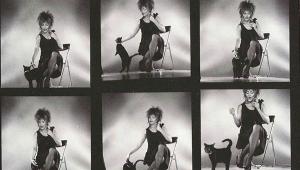FineLine LCR-21 On-Wall Speaker System
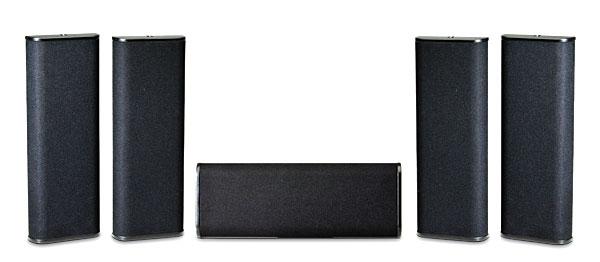
As I sit in my theater room writing this, there’s an interesting juxtaposition in front of me. On the wall are three FineLine LCR-21 speakers neatly mounted around my Samsung plasma HDTV. Now that I’m finished with my listening tests of the FineLines, I’ve hauled my next set of review speakers (a MartinLogan ElectroMotion system) into the room in order to finish burning them in. The main MartinLogan EM-ESLs are floorstanding speakers that need to be positioned out from the wall to sound best. So there it is: small, svelte, unobtrusive panels on the wall versus slender, 52-inch-tall towers (plus associated speaker wires and power cables on the floor) that are unmistakably part of an audio system.
My point isn’t to say that one approach is necessarily better than the other. Your outlook on life will determine which implementation looks and works best. In my house, the family is split as to which is ideal—and it doesn’t strictly follow gender lines, either. (I didn’t ask our cats, but past experience has taught me that cloth-covered tower speakers make nearly irresistible scratching posts.) I bring it up because way in the back of my mind I’ve harbored a secret tidbit of disdain for people who rush to use on-wall or in-wall speakers as the main LCRs in their theater systems. Not that there aren’t some really fine-sounding on-/in-wall speakers out there. It’s that my inner audiophile kept whispering that these people didn’t really care about sound quality.
This may appear to be hypocritical on my part (not unusual) because my everyday theater speakers are five Legacy Harmony in-walls. But since the Legacys are over 40 inches tall and extend 2 inches into the room—even after requiring 3.75 inches of depth in the wall— they’re hardly your typical on-/in-wall speaker. Now, though, after having reviewed a couple of on-wall speaker systems in a row, the physical contrast between that form factor and a system with floorstanding towers is so stark that I have to admit to a grudging appreciation of why so many people gravitate to the off-the-floor variety.
Who the Heck Are You?
I’d lay significant money on the fact that if I asked you to name all the brands of speakers you can think of, FineLine wouldn’t be among them. Nor would the parent company, Innovox Audio. That’s mainly because, until recently, Innovox primarily provided speakers to the pro/commercial A/V market. And these aren’t for your local DJ’s system, either. Some of the venues that use custom-designed Innovox speakers include the terminals in the San Jose International Airport and Cirque du Soleil’s theater in the Mirage hotel for the troupe’s Beatles Love show, which involves over 6,000 channels of surround sound. (Dolby Digital 6000.1 for home theaters? Bring it on!) FineLine is Innovox’s initial step into the mainstream consumer market.
At the moment, FineLine’s lineup includes two models of on-wall speakers, an on-wall LCR soundbar, and a powered subwoofer. You won’t find any of them at a local dealer, though, because the speakers are only available online directly from FineLine. Since you can’t audition them in a store, FineLine wisely has a 30-day money-back policy so you can try them out at home. (As far as I’m concerned, this is an absolute must for any online-only outfit.) In my case, of course, I didn’t have to supply FineLine with a credit card for them to ship five of their top-of-the-line LCR-21 ($395 each) on-wall speakers. FineLine makes a compact powered subwoofer, but since my theater room is fairly large, I chose to use a larger, beefier Definitive Technology model I already had on hand.
These Speakers Are a Steel
From a design and component standpoint, the LCR-21 is surprisingly simple. Phil Jones, FineLine’s brand manager and the engineer who designed the drivers, explained the design to me. The speakers start with a cold-rolled steel cabinet (rather than the more typical aluminum cabinet) in order to minimize the thickness of the cabinet walls. In each of the LCR-21’s two 4-inch HVX midbass drivers, the motor is positioned in front of the driver rather than behind in order to minimize cabinet depth. (This front-motor design shows up in other thin speakers, too.) The more interesting part about the HVX drivers is that the neodymium magnet is bolted directly to the speaker’s metal front panel, which means that the speaker cabinet itself is essentially the frame of the driver. Situated between the two HVX drivers is a 3-inch planar magnetic tweeter in the middle of the front bezel.
The LCR-21’s steel cabinet is about 1.75 inches deep. That’s not the thinnest on-wall speaker on the market, but it’s close. At 18.5 inches tall and 6.75 inches wide, it’s also on the smaller end of the scale in terms of physical footprint on the wall (wallprint?). Although I’d describe the speakers’ minimalist aesthetic as very plain, that doesn’t mean they’re ugly. On the other hand, they’re not going to show up on display at the Museum of Modern Art. The LCR-21 is basically a rectangle with rounded front right and left sides that’s wrapped in either white (really off-white) or black grille cloth, with matching-color top and bottom wooden end caps. The end caps aren’t just for looks—they’re actually end plugs. In other words, they’re a part of the cabinet that seals the structure. Inside, the speaker is braced by wooden dowels and includes damping compound to reduce cabinet resonance.
Their Backs Against the Wall
The LCR-21 comes with a Ushaped mounting bracket that makes it very easy to install the speaker. After you attach it to the wall, the bracket’s ends slide into the speaker’s end caps, making it totally invisible. There’s a narrow slot in each end cap for the screw that tightens the speaker to the bracket. The slots provide about five-eighths of an inch of adjustment in or out, so you can mount the speaker flat against the wall or slightly off it if you’re running speaker wire outside rather than inside the wall.
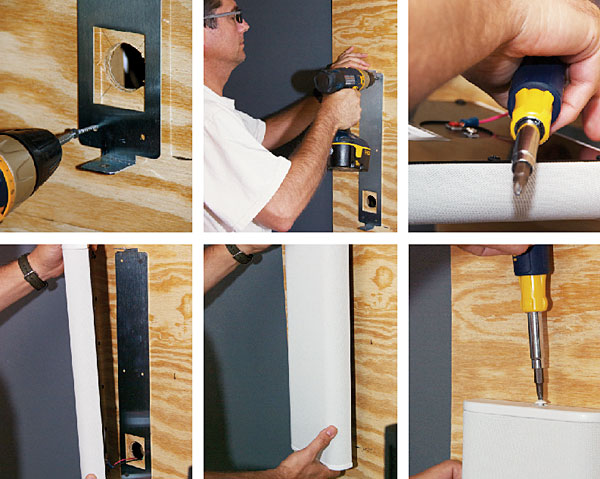
In another attempt to minimize the depth of the speaker cabinet, the LCR-21 has screwdown terminals on the back for speaker wire connections. FineLine includes small crimpon spade lugs that are fine if you’re using 18-gauge or smaller wire. If you plan to use anything thicker, count on a trip to the hardware store. Although I like the idea of the screw-down terminals, I think FineLine should include bigger, better-quality spades—it wasn’t long before I’d succeeded in snapping one of the supplied spade lugs with a bit of what was evidently overzealous crimping.
